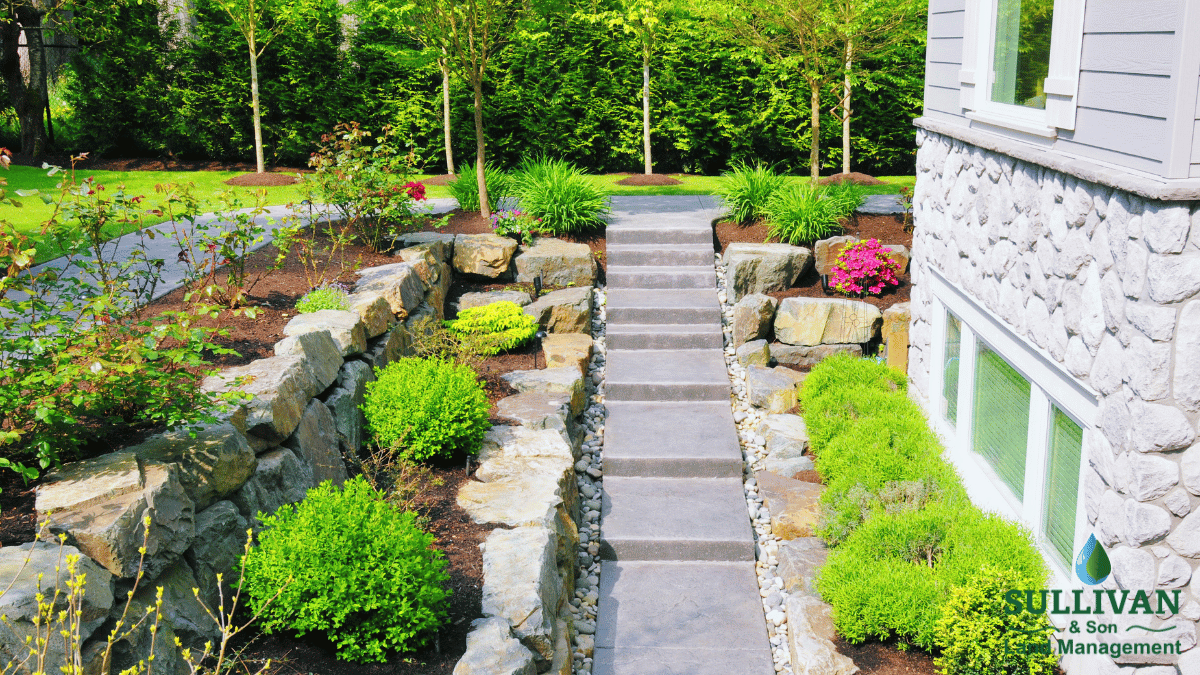You can have the prettiest perennials in Fairfield County in your yard, but if your patio is cracked from last winter’s deep freeze or you expect to slip and fall on a new-fallen layer of leaves when the snow melts, then it’s fair to say your outdoor space isn’t serving you well. Hardscape — that is, the patios, walkways and retaining walls that create your landscape’s bare bones — is what separates a yard you can actually use from one that isn’t much more than pretty to gaze at through a window.
We’ve done enough Stamford projects to know the local topography isn’t doing you any favors. Sloping plots, wet springs and winters that cycle between freeze and thaw several times mean your hardscape must function as more than just eye candy. It has to accommodate drainage, remain flat season after season and provide safe, solid footing all year long. A good patio done right extends your living space from, say, May to October. If constructed properly, a retaining wall can be the difference between having unusable steep slopes on your property and creating terraced walls and raised planters that make uphill gardening possible.
Your Patio's the Heart of It
In our work we start with the patio, followed by most of the backyard. It’s where the grill is, where you set up the dining table, where people tend to gravitate. This is one where size does matter—you’ll need at least 12x16 feet for a table and chairs, more if you’re adding a fire pit or lounge seating. (Bluestone’s our go-to for Stamford homes.) It fits with the New England aesthetic, doesn’t get slippery when wet and stands up to freeze-thaw cycles without popping or cracking. Flagstone also works if you prefer a looser, more organic look. Pavers offer you more color options, and generally cost about 30% less than natural stone, though they will move over time if the base isn’t perfect.
Here’s what people get caught up by: they look at the patio in July and not January. Stamped concrete may look nice, but if it’s not put in with enough depth and proper drainage, it can crack here. We’ve fixed enough of those to recommend materials that actually endure.
Walkways That Work Through Connecticut Weather
A good path leads you seamlessly from the driveway to your front door without you even having to think about it. We also come across many straight-shot paths that look forced; sometimes a meandering curve to even out your property’s natural grade makes more sense and looks better. Brick ages fairly gracefully into that classic New England look, though it can be a bit slippery when wet. Choose bluestone or thermal bluestone (the latter has a more textured, rough surface) and you will have better traction in the rain.
Width is even more of an issue that people realise. Two people walking side by side barely fit on the 3-foot-wide path. We usually engineer main walkways at 4 to 5 feet. Secondary paths that lead to garden spaces can be a bit narrower — 30 to 36 inches is fine there.
Retaining Walls Aren't Optional on Slopes
If your property has significant slope, you have erosion, whether you are seeing it or not. We’ve walked properties where homeowners had no idea they were losing 2 to 3 inches of topsoil every year until we pointed out the exposed roots and the way water cut through after a storm. A retaining wall takes care of that by keeping the soil in place and channeling water where you need it to go.
Walls of natural stone seamlessly fit into Stamford’s wooded, hilly terrain. They’re not cheap (think high end in terms of materials and labor) but will outlast you. Cinder blocks work great, especially the nice new ones with different textures that don’t look like industrial cinder blocks. You can also stair-step or terrace your way up the slope to form flat areas for planting beds or seating.
It’s the engineering that counts here, not aesthetics. Any wall higher than 3 feet that’s retaining soil needs to have good drainage behind it — crushed stone backfill and perforated pipe — or a freeze/thaw cycle will propel your hard work over the edge, so to speak. We have rebuilt enough retaining walls done poorly the first time to know where corners are cut.
What Actually Works in Stamford
Your hardscapes must be able to endure our specific conditions. That includes materials designed for freeze-thaw cycles, the correct depth in a base (at least 6 to 8 inches of compacted gravel for patios and walkways) and proper grading to move water away from your foundation. If your property is on one of Stamford’s steeper angles, the drainage plan is as significant as the design.
Begin by envisioning how you’ll use the space. We can design something lovely that looks great on paper, but if it doesn’t fit how your family lives outside of the house, it won’t get use.” Walk your property in different seasons, notice where water pools, where the ground tends to stay muddy, and where you would instinctively want to sit or walk. That tells you what you need




